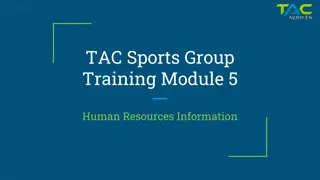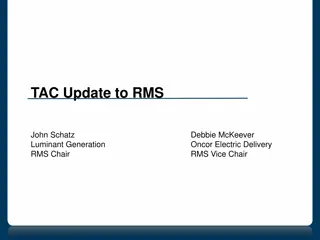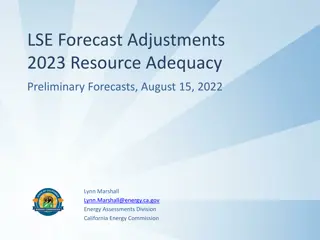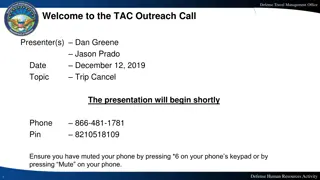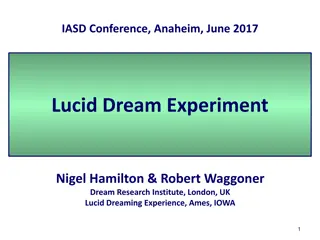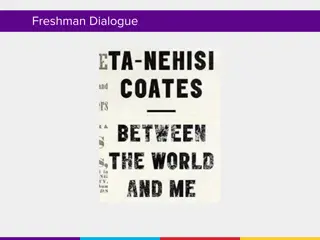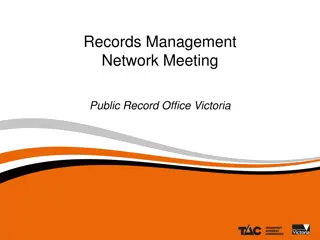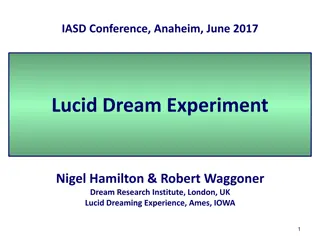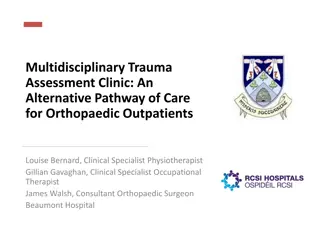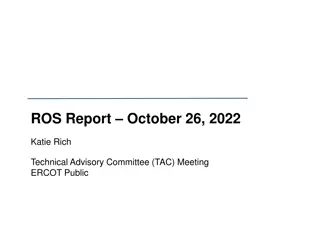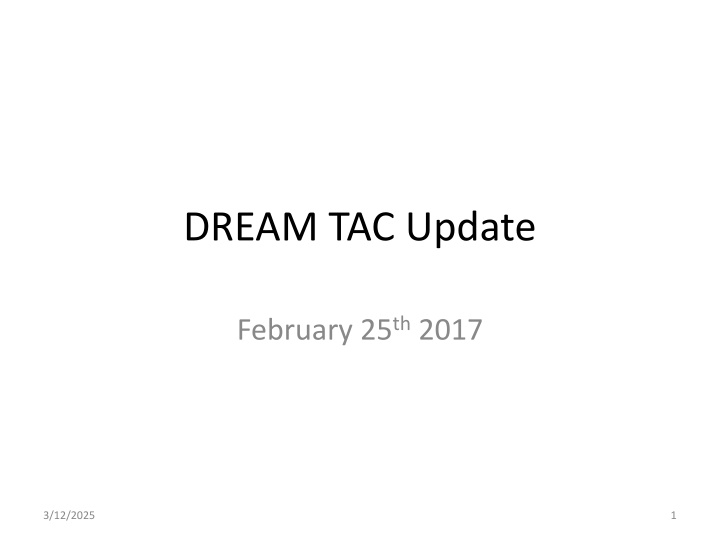
DREAM TAC Update
ERCOT's Technical Advisory Committee chartered a Task force to investigate the regulatory and market framework for distributed resource participation, focusing on process improvements, equity, practicality, and system reliability.
Download Presentation

Please find below an Image/Link to download the presentation.
The content on the website is provided AS IS for your information and personal use only. It may not be sold, licensed, or shared on other websites without obtaining consent from the author. If you encounter any issues during the download, it is possible that the publisher has removed the file from their server.
You are allowed to download the files provided on this website for personal or commercial use, subject to the condition that they are used lawfully. All files are the property of their respective owners.
The content on the website is provided AS IS for your information and personal use only. It may not be sold, licensed, or shared on other websites without obtaining consent from the author.
E N D
Presentation Transcript
DREAM TAC Update February 25th2017 3/12/2025 1
Introduction ERCOT s Technical Advisory Committee (TAC) chartered a Task force to investigate the current regulatory and market framework for distributed resource participation. Process https://encrypted-tbn2.gstatic.com/images?q=tbn:ANd9GcT6-haXYU56eCci_Ljtzc3p33z8uRC8igy6Y9uWoqxgWznn0G7nNebiVMI DG Practica lity Concept Paper Equity https://encrypted-tbn2.gstatic.com/images?q=tbn:ANd9GcQ84CPvPxNjLhCXqTrNwNdareagbh97S7X1v-zosfK80rMyE4cuv2IHyWjT Reliability The DREAM Task Force reviewed specific topics while considering process improvements, equity with traditional resources, practicality of implementation, and system reliability.
Comparison: WP proposals / DREAM Review The ERCOT Whitepaper offered a spectrum of market frameworks to further discussion DG Integration DREAM tackled issues and shortcomings with existing practices.
Targeted topics DREAM held focused meetings on 1. Definitions, Reporting, Distribution Awareness, and potential DG Aggregation Rules 2. Interconnection Procedures, Metering, and Modeling 3. Local Pricing (Nodal), Resource Optionality 4. Compliance Metrics
Definitions and Reporting DEFINITIONS: Stakeholders observed a gap in current protocols; issued an NPRR to improve DG boundaries. Current protocols are not explicit for: DG 10 MW or greater but connected at a distribution voltage DG that intends to inject to the Distribution System, rather than reduce load Use of the term Customer (ambiguous reference to distribution customer, load, etc.) REPORTING: TDSPs currently report, annually, registered and non- registered DG in a PUC filing. The filing is only available in scanned PDF form (very difficult to sort and analyze.) *Individual MPs filed NPRR 751, 757 to address Definitions and Reporting, respectively.
Reporting (Continued) NPRR 719 and COPMGRR040 Removes the requirement to lower the Distributed Generation (DG) Registration Threshold, Modifies the ERCOT DG report to include all unregistered DG sites in competitive territories by MW capacity by Load Zone and by the following primary fuel types. Certain Market Participants suggested that similar improvements to Reporting on DG should be investigated in Non-Opt-In Entities (NOIE)
Lessons Learned: Distribution Awareness ERCOT performed assessments of installed DG capacity, but lacks precise knowledge of Resource availability, behavior, and responsiveness to price. Additionally, ERCOT does not have centralized dispatch authority of DG.
Lessons Learned: Distribution awareness and Existing Landscape of DG *ERCOT reported unregistered values based upon competitive choice areas only, as submitted by each TDSP via profile codes.
Reliability Lessons Learned: MP/ERCOT Visibility and dispatch ERCOT expressed concerns about managing a grid that includes a growing population of distributed resources with limited visibility and no centralized dispatch function (SCED.) At least one market participant was concerned about the limited transparency and behavior of price-responsive DG.
Lessons Learned: Interconnection Processes Numerous market participants provided a detailed description of interconnection processes for distributed generation. Generally, interconnection processes were consistent throughout ERCOT, and varied as needed on a system specific basis. The Task Force did not propose changes to the Interconnection Processes conducted by the TDSPs.
Process Lessons Learned: Modeling / Mapping DG neither prohibited nor enabled to become Mapped to a Resource Node Certain Market Participants expressed interest in mapping their DG to a new Resource Node. Resource Nodes enable a Generation / Load Resource to participate in Security Constrained Economic Dispatch, Ancillary Service Markets, and Congestion Revenue Right (CRR) Markets. ERCOT s Business Practice does not have explicit provisions (or prohibitions) for DG to establish a Resource Node.
Mapping Resource Nodes ERCOT does not currently (nor does it intend to) model the distribution system. However, to perform a dispatch for distribution connected resources, ERCOT must know where the resource connects relative to the ERCOT transmission system. Currently, ERCOT maps distribution-connected Load Resources participating in RRS to a CIM (Common Information Model) Load and associated transmission interconnection point. Expanding this practice to DG is possible, but the details and concerns have yet to be resolved. ERCOT / ERCOT Stakeholders have not determined if DG should be mapped at a LZ or more granular level.
Resource Nodes Enable Participation in SCED Participation in DAM, AS Markets Participation in CRR Markets To date, no market participants have expressed interest in participating in CRR Markets. DREAM suggests TAC consider development of a Resource Node that does not include participation in CRR Markets. (e.g. Distribution Node)
Resource Node Alternative Continue to Map DG to a Load Zone (status quo) but enable: Ancillary Service participation, and Load Zone dispatch, and Maintain Load Zone Settlement. DREAM suggests further discussion, potentially within WMS.
Mapping Resource Nodes: Distribution switching To a limited extent distribution switching may temporarily or permanently re-locate a resource s electric location relative to the transmission system. Transmission and distribution provider one- line diagram / visibility ERCOT visibility Sub 1 Sub 2 CIM Load CIM Load DG1 Distribution switching is not currently modeled by ERCOT
Mapping Resource Nodes: Distribution switching issues ERCOT has no visibility into distribution switching. If a resource were switched as a consequence of normal or emergency utility operations, the electrical path to the transmission system could change. Pricing and operations of the DG may change as a consequence of a switch. Solutions may include Select a reasonable transmission location for mapping, and ignore the potential for switching Electrical locations will likely be similar, based upon physical limitations to load switching Switching may be infrequent Alternatively, ERCOT could calculate a blended location based upon numerous switchable locations.
Practicality Lessons Learned: DG participation in CRR Markets needs further review CRR markets operate with a finite number of Resource Nodes (~600) CURRENT DG INSTALLATIONS RECEIVE LOAD ZONE (LZ) PRICING WHEN INJECTING, REGARDLESS OF ELECTRICAL LOCATION WITH A LZ ERCOT s current DG population exceeds 7,600 unique sites (Competitive Areas only.) ERCOT s Stakeholder Process is reviewing 1. 2. 3. 4. DG interest in CRR Market Participation ERCOT System Limitations, based upon (1) Market efficiency based upon (1) and (2) Alternatives, including status-quo Load Zone Hedge
DG Participation in CRR Markets Distributed Generation and its impact to radial constraints Background: Distributed Generation has expressed interest in becoming associated with a resource node. Historically, an established resource node allows participation in SCED, and CRR Markets. Should stakeholders consider a DG / RN that excludes CRR activity? No market participants have expressed a desire for DG/CRR participation, electrically similar nodes may suffice for hedging.
Alternative transmission hedging for Distributed Generation Is it appropriate for distributed generation to participate in CRR markets? Currently, Distributed Generation is, by virtue of their settlement, hedged to load zone regardless of location. If DG is not allowed to establish a RN associated with their site: Are nearby existing electrical nodes sufficient to hedge congestion risk? Other Solutions?
Mobile Generators / CRR Game If mobile DG is allowed to establish a Resource Node that enables participation in CRR markets and Controls other DG interconnection sites that enable a resource to move, and are on opposing sides of a constraint, then That resource owner could benefit from a CRR position that they could influence by moving a resource. T/D Sub s Mobile DG Interconnection Mobile DG Interconnection DG 9MW 10MW Mobile DG This is only an issue if new market rules enable DG association with a RN with CRR participation.
Equity Lessons Learned: DG Economic Outages Certain Market Participants expressed a desire to withdraw DG capacity associated with a Resource Node (if modified market rules allow DG affiliation with a RN) to self-serve load at the same site. LZ $ LZ $ Nodal $ or LZ$ LZ $ M M M M M DG DG Load Load Behind-the-meter storage (not pictured) settled at a nodal price introduces additional, yet to be resolved issues.
Equity Lessons Learned: DG Resource Node Optionality Traditional Resources typically remain associated with a Resource Node for the entirety of their commercial operations. Certain Market Participants expressed the desire to change their election to be mapped to a Resource Node (assuming association DG Resource Nodes are an option.) Optionality to deliver to a Resource Node or Load Zone adds to DG value, but does not necessarily correspond to traditional Resource rules.
Load Zone/Nodal Optionality Nodal and Load Zone prices may diverge when constraints bind Resources and Loads may get inconsistent pricing at the same electrical bus Electrically equivalent location
Nodal and Load Zone Price Divergence If a customer site is in a load pocket within a Load Zone, Nodal prices may be very high, while Load Zone prices are relatively low. If a customer site is in a generation pocket within a Load Zone, Load Zone pricing may be very high, while Nodal prices are very low
Equity Lessons Learned: Allowances for DG Aggregations Aggregating Load Resources in ERCOT were established to enable participation in Ancillary Service and Energy Markets. To date, none have qualified for any service. Aggregations enable smaller resources to participate in ERCOT markets that were previously inaccessible due to minimum size limitations. Aggregations for DG may enable increased participation in ERCOT Ancillary Service and Energy Markets
Aggregation limitations Historically, Aggregated Load Resources (ALRs) must all be located in the same Load Zone. Moving forward, stakeholders suggested we investigate: Aggregations constrained by QSE, and dispatched based upon a weighted shift-factor Aggregations constrained by Load Zone Aggregations constrained by a pre-determined assessment of electrical equivalence (e.g. all resources within the aggregation have similar shift factors relative to constraints) Aggregations by DSP Footprint
Equity Lessons Learned: Settlements DG utilizing fossil fuels for their prime mover often have spent fuel associated with a self-dispatch in response to ERCOT Load Zone Prices. DG injecting to the grid are typically settled during final settlements (55 days after the operating day) despite the availability of Advanced Metering Infrastructure Data (AMI) sufficient for expedited settlement. ERCOT has authored and submitted NPRR 753 to allow expedited settlement timelines for DG.
Reliability lessons learned: Compliance Self-Dispatched DG does not face the same obligations and compliance metrics as traditional resources (e.g. Reliability Unit Commitment (RUC), Base-point Deviation Charges, etc.) The DREAM Task Force reviewed existing compliance metrics that can be adapted to be appropriate for DG that opts to participate in ERCOT Markets. Existing compliance metrics for the following programs reviewed included: Emergency Response Service, Base-point Deviation, Voltage Support and Governor Response, Response to High/Low Voltage (LVRT) and Frequencies (UF relaying set- points), and Ancillary Service Performance Criteria (if applicable.)
Questions / Potential Votes? DREAM TF seeks TAC direction on the following policy cuts: 1: To enable and define distributed resources eligible to participate in the DAM with a Three- Part Supply Offer, Ancillary Service Offer, DAM offers/bids, CRR offers/bids, and/or QSE to QSE transactions, TAC directs DREAM to develop revisions to existing Protocols to achieve these ends, given existing PUCT rules. Revisions should include detailed requirements for registration, modeling, metering, pricing options, and compliance metrics associated with distributed resources participation. 2: Direct CMWG to review eligibility for Resource Nodes created for distributed resources to participate in CRR markets and report back to DREAM/TAC, including a review of the necessary revisions to Load Serving Entity (LSE) Settlement calculations for customers with nodal distributed resources. 3: Direct QMWG/DREAM to propose Protocol revisions, consistent with PUCT rules, to allow distributed resources registered with a Resource Node to allow for economic outages, including but not limited to, those outages initiated to allow a Load co-located with the DG to consume its output, and report back to TAC.
Questions / Potential Votes: 4: Direct QMWG and DSWG to update the ALR Other Binding Document and associated Protocols to reflect Option #(s) ___, detailed above in the Provisions for Aggregations section of this document. 1. Create aggregated distributed resources with a Load Zone-level identity 2. Create aggregated distributed resources with similarly situated electrical locations. 3. Create aggregated distributed resources with nodal identity at a resource level and a corresponding portfolio with weighted shift factors 4. Create aggregated distributed resources without shift factor limitations, as standard SCED operations would place curtailment risk on the aggregated DER should it contain systems with shift factors requiring curtailment (i.e. a lowest common denominator for reliability risk is applied to the entire aggregation). Thus Market Participants would be encouraged to design aggregations with nodal topography that makes the most economic sense for the participants in the aggregation. 5: Consider who should bear the cost of EPS meters deployed to support distributed resources, or put this matter on hold as we wait for the NPRR on use of AMI meters instead of EPS to work its way through the approval process.
Questions / Potential Votes: 6. Direct WMS / QMWG /DWSG to review the market impact of the status quo treatment for price responsive distributed resources. Passive distributed resources (e.g. solar, wind, or other non-price-responsive resources receiving negative Load Zone pricing when injecting) should be excluded from this assessment. WMS may consider and/or propose alternative arrangements that improve visibility and/or ERCOT control of price responsive resources. 7. Enable a distributed resource above a specified size to participate in energy and Ancillary Service markets on equal footing with a traditional resource by absorbing the cost of an EPS meter (in the rate base) per point of interconnect with the distribution system in the rate base, or put this matter on hold as we wait for the NPRR on use of AMI meters instead of EPS to work its way through the approval process. 8. Enable distributed resources to change their registration on a nodal basis (e.g. for the periodic inclusion and removal systems within an aggregation) and to allow a single registered distributed resource or an aggregation to participate in a Load Zone portfolio dispatch. The quickest frequency of either or both types of registration change should be X month(s).


![❤Book⚡[PDF]✔ Spaceplane HERMES: Europe's Dream of Independent Manned Spaceflight](/thumb/21517/book-pdf-spaceplane-hermes-europe-s-dream-of-independent-manned-spaceflight.jpg)
